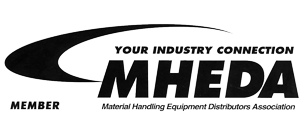7 Forklift Hand Signals to Improve Workplace Safety
October 01, 2021 - Last modified: July 26, 2022 @ 3:22 pm
Learning about forklift hand signals is as important as learning about forklift controls. Both are essential to safe forklift operation.
Forklifts can be very dangerous. One in every ten operators experiences a forklift accident, some of which are fatal. Prevent accidents by practicing OSHA forklift hand signals and operating with caution. Learn more about general forklift safety tips here.
Forklift accidents are more common than they should be. Most forklift fatalities occur from a lack of situational awareness. Utilizing forklift hand signals increases communication among operators and other employees, ensuring that everyone is on the same page. This will also improve forklift pedestrian safety.
How to Use Forklift Signals
OSHA has developed a standardized set of hand signals that are easy to use and interpret. A designated spotter should use these forklift signals to help operators navigate. Spotters should watch the load, not the operator, when using signals. Operators should watch the spotter.
Operators should only respond to signals from a designated spotter. There must only be one spotter per person to prevent confusion. However, if anyone gives the emergency stop signal, the operator must follow it, even if the person giving the signal is not the designated spotter. This will help ensure forklift pedestrian safety.
Operators and spotters must learn the same OSHA forklift hand signals to prevent miscommunication and ensure consistency. Streamline your training process to ensure everyone is on the same page.
Using forklift signals is the most reliable and direct method of communication. Most operators work in noisy environments that impair communication. Forklift hand signals help convey information when verbal warnings are not enough. Learn about the seven major forklift signals below.
7 Forklift Hand Signals
These seven OSHA forklift hand signals are universal. Every business that operates a forklift uses them.
Make sure that you introduce these forklift signals to your workers. Initiate refresher training periodically, or monitor the use of the signals in your warehouse. It is up to you to protect forklift pedestrian safety in your workplace.
Involve other employees as well. Teach forklift safety tips for moving around heavy machinery. Even if they don't operate forklifts, show them the emergency stop signal and prepare them for situations where they may interact with machinery.
Raise the Tines
This OSHA forklift hand signal is directly related to the tines, or forks.
To signal to the operator to raise the forks, extend your forearm vertically, keeping it perpendicular to the ground. Then, point your forefinger up and move your hand in small circles. Continue this circular motion until the tines are high enough.
Lower the Tines
Extend your right arm parallel to the ground with your palm down. Lower your arm until the tines are at the desired level.
Move the Tines
This is the third, and final, forklift signal for tines. To get the operator to move the tines, or forks, in the direction of your fingers, follow these steps.
First, extend your arm out from your side, parallel to the ground. Then, with a downward palm, point your forefinger in the direction of the desired movement.
Tilt Mast Forward
Extend your right arm parallel to the ground. Then, with your thumb pointing downward, lower your arm towards your side. Repeat this movement until the mast reaches the desired angle.
Tilt Mast Back
Extend your thumb while keeping the forearm of your right arm vertical to the ground. Then, jerk that extended thumb over your right shoulder. Repeat this slowly and continuously, so the operator can follow your movements.
Dog Everything
“Dog everything” refers to getting an operator to immediately pause. This is an emergency hand signal.
To demonstrate, clasp your hands in front of your body or navel. This is generally used in unplanned situations that present a safety hazard. It’s often used as a preventative measure for forklift pedestrian safety. For instance, if someone enters a warehouse and could potentially walk in a forklift’s path, use this forklift signal.
Emergency Stop
The emergency stop, as the name implies, is another emergency signal. This is different from “dog everything”, though. Where the former signals a pause, this one incites a hard stop.
To communicate an emergency stop, extend both arms out. Keep both palms down, ensuring your arms are parallel to the ground.
This is the only sign that non-spotters can communicate to the operator.

Forklift Inventory
A good spotter system with proper forklift hand signals will strengthen your workplace’s safety. However, you’ll still need to take additional steps to ensure maximum safety. One of these steps is using reliable equipment. That’s where Forklift Inventory comes in.
Forklift safety tips can only protect your employees to a certain extent. The equipment they use also poses a large safety threat if not in proper condition.
Luckily, Forklift Inventory partners with dealers that carry reliable, durable equipment. If you're ready for an upgrade, fill out this form to get free quotes on quality options in your area. Comparing prices instantly. Save time and money with Forklift Inventory.
Get the Best Deal on Reliable Equipment with Forklift Inventory
Further Reading:
- How to Operate a Sit-Down Forklift Safely
- 8 Warehouse Safety Tips You Need to Implement
- How to Prioritize Forklift Safety in Your Warehouse
Compare Forklift Prices
Forklift Inventory has the largest online selection of forklifts, aerial lifts and construction forklifts. Compare new and used forklifts to get the lowest prices available.




